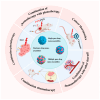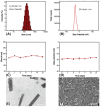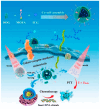Advances in Pure Drug Self-Assembled Nanosystems: A Novel Strategy for Combined Cancer Therapy
- PMID: 39861716
- PMCID: PMC11768559
- DOI: 10.3390/pharmaceutics17010068
Advances in Pure Drug Self-Assembled Nanosystems: A Novel Strategy for Combined Cancer Therapy
Abstract
Nanoparticle-based drug delivery systems hold great promise for improving the effectiveness of anti-tumor therapies. However, their clinical translation remains hindered by several significant challenges, including intricate preparation processes, limited drug loading capacity, and concerns regarding potential toxicity. In this context, pure drug-assembled nanosystems (PDANSs) have emerged as a promising alternative, attracting extensive research interest due to their simple preparation methods, high drug loading efficiency, and suitability for large-scale industrial production. This innovative approach presents new opportunities to enhance both the safety and therapeutic efficacy of cancer treatments. This review comprehensively explores recent progress in the application of PDANSs for cancer therapy. It begins by detailing the self-assembly mechanisms and fundamental principles underlying PDANS formation. The discussion then advances to strategies for assembling single pure drug nanoparticles, as well as the co-assembly of multiple drugs. Subsequently, the review addresses the therapeutic potential of PDANSs in combination treatment modalities, encompassing diagnostic and therapeutic applications. These include combinations of chemotherapeutic agents, phototherapeutic approaches, the integration of chemotherapy with phototherapy, and the synergistic use of immunotherapy with other treatment methods. Finally, the review highlights the potential of PDANSs in advancing tumor therapy and their prospects for clinical application, providing key insights for future research aimed at optimizing this technology and broadening its utility in cancer treatment.
Keywords: cancer therapy; carrier-free; combination treatment; nanosystems; pure drug; self-assembly.
Conflict of interest statement
The authors declare no conflicts of interest.
Figures













Similar articles
-
Emerging carrier-free nanosystems based on molecular self-assembly of pure drugs for cancer therapy.Med Res Rev. 2020 Sep;40(5):1754-1775. doi: 10.1002/med.21669. Epub 2020 Apr 7. Med Res Rev. 2020. PMID: 32266734 Review.
-
How the Versatile Self-Assembly in Drug Delivery System to Afford Multimodal Cancer Therapy?Adv Healthc Mater. 2025 Jan;14(3):e2403715. doi: 10.1002/adhm.202403715. Epub 2024 Nov 25. Adv Healthc Mater. 2025. PMID: 39587000 Review.
-
Recent advances in phototherapeutic nanosystems for oral cancer.J Mater Chem B. 2024 Nov 20;12(45):11560-11572. doi: 10.1039/d4tb01919a. J Mater Chem B. 2024. PMID: 39420670 Review.
-
Pure drug nano-assemblies: A facile carrier-free nanoplatform for efficient cancer therapy.Acta Pharm Sin B. 2022 Jan;12(1):92-106. doi: 10.1016/j.apsb.2021.08.012. Epub 2021 Aug 14. Acta Pharm Sin B. 2022. PMID: 35127374 Free PMC article. Review.
-
Advancing gastric cancer treatment: nanotechnology innovations and future prospects.Cell Biol Toxicol. 2024 Nov 20;40(1):101. doi: 10.1007/s10565-024-09943-9. Cell Biol Toxicol. 2024. PMID: 39565472 Free PMC article. Review.
Cited by
-
Nanotechnology in oncology: advances in biosynthesis, drug delivery, and theranostics.Discov Oncol. 2025 Jun 21;16(1):1172. doi: 10.1007/s12672-025-02664-3. Discov Oncol. 2025. PMID: 40542991 Free PMC article. Review.
References
Publication types
Grants and funding
LinkOut - more resources
Full Text Sources

